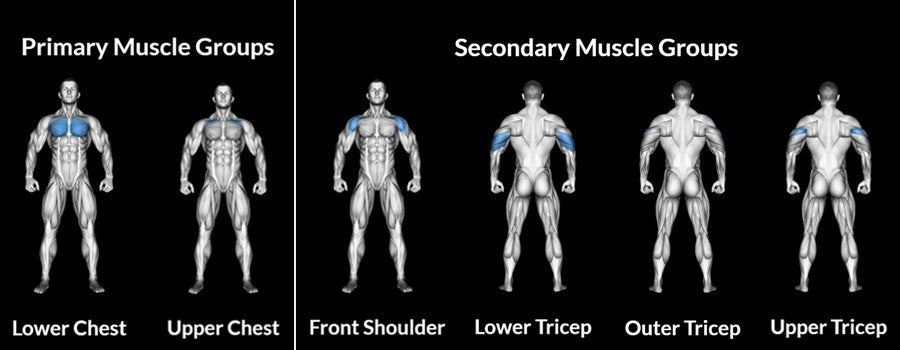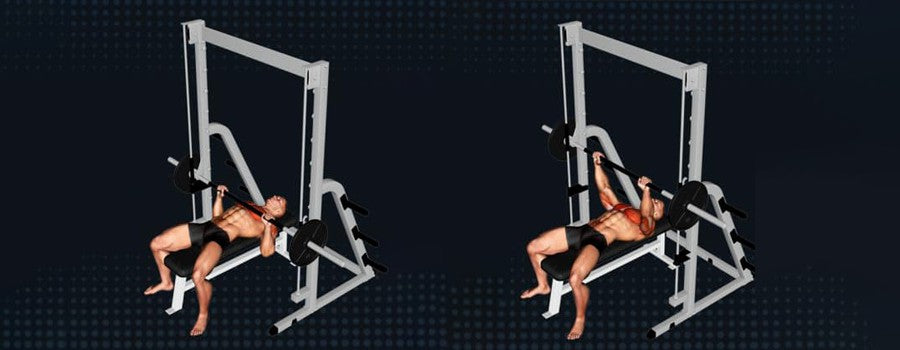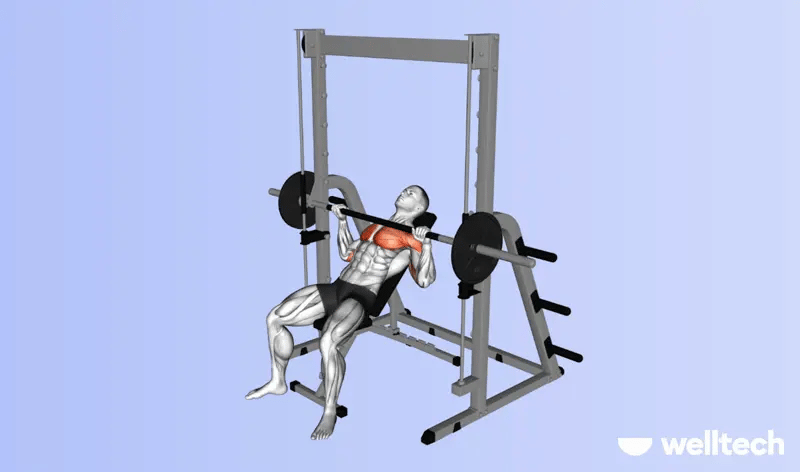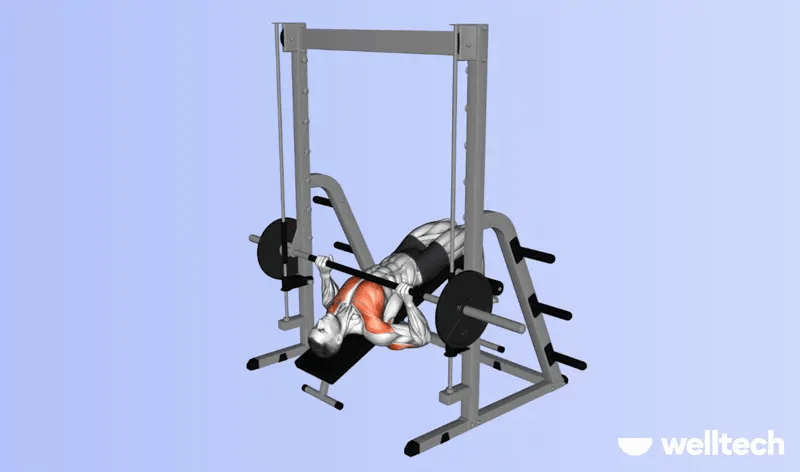How To Do Bench Press On Smith Machine: Forms, Muscles, Benefits& Variations
The Smith machine bench press is a variation of the traditional bench press, utilizing a specialized weightlifting equipment called a Smith machine. This machine features a barbell securely affixed to steel rails, restricting its movement to vertical or horizontal motion and facilitating the addition of weight plates for increased resistance.

Commonly employed by bodybuilders, powerlifters, and strength enthusiasts, the Smith machine bench press effectively targets chest muscles and enhances upper body strength. It also serves as an excellent choice for beginners and those new to weightlifting due to the fixed barbell path, enabling a stable and controlled movement, especially beneficial when exercising without a spotter.
Muscle Worked By The Smith Machine Bench Press
Before delving into the proper usage of the Smith Machine, let's first explore the muscles engaged during Smith Machine exercises. When performing bench presses on the Smith Machine, the muscles worked are essentially the same as those involved in traditional barbell bench presses, with a single distinction. During Smith Machine bench presses, your stabilizer muscles have a somewhat reduced workload in maintaining the bar's correct path. Nevertheless, whether it's a standard bench press or a variation, you'll likely be employing comparable muscle groups to press the weight.

Pectoralis
Known as the pectorals or "pecs," these muscles reside on both sides of your chest and play crucial roles in arm flexion, adduction, and internal rotation. Consistent exercise can lead to their growth, contributing to a well-defined physique.
Comprising the pectoralis major and pectoralis minor, the pectoralis major is the muscle responsible for the chest's robust appearance. Working on the chest is essential for enhancing posture, expanding the range of motion, and alleviating neck and upper back discomfort. Among the most effective exercises for strengthening the pecs and the entire upper body is the bench press.
Deltoids
The shoulder, comprising the anterior, medial, and posterior deltoid muscles, plays a pivotal role in arm movements like abduction, flexion, and extension, while also providing stability to prevent dislocation and compensate for rotator cuff injuries. Weak shoulders not only heighten the risk of injury during workouts but also in everyday activities involving overhead lifting or reaching.
During the bench press, the anterior deltoids are the primary target, with contributions from the medial and posterior deltoids depending on the bench angle. It's essential to note that the Smith Machine bench press engages the shoulder muscles, albeit as stabilizers, potentially recruiting them less than a standard bench press.
👉👉👉Click herer for more information about how to workout your shoulder with adjustable dumbbells.
Triceps Brachii
In the bench press, the phase at the lift's apex is termed the "lockout phase," where the triceps play a pivotal role. Comprising three heads – the medial, lateral, and long head – the triceps are situated at the back of the arm and primarily function in elbow extension. Weak triceps can detrimentally affect your bench press performance, particularly during the lockout phase. Furthermore, they can potentially lead to issues such as shoulder discomfort, restricted range of motion, and potential long-term shoulder problems.

While the triceps also serve as stabilizers in the bench press and can be strengthened through this exercise, it's worth noting that the use of a Smith Machine may provide additional support, potentially limiting their engagement.
While a standard bench press activates several stabilizer muscles to aid in the motion, the Smith Machine minimizes their engagement significantly. These stabilizing muscles encompass the rotator cuff muscles (comprising the infraspinatus, supraspinatus, subscapularis, and teres minor), serratus anterior, latissimus dorsi, trapezius (particularly the middle and lower traps), biceps brachii, and the core.
PMAX-4550 Red & Black Multi Functional Smith Machine |
RitKeep PMAX-5600 Black Multi Functional Smith Machine With Weight Stack |
 |
 |
How To Do Bench Press With Smith Machine

Step #1: Set up for the press
Before beginning, ensure that your bench is precisely centered within the machine's rails. Lie on the bench with an empty bar and make adjustments by shifting your position forward or backward to determine the optimal bar path relative to your torso. We suggest unracking the bar without weights and performing a few repetitions to establish your setup, aiming for the bar to lower to your lower chest, ideally aligned with the nipple line or just below it.
Step #2: Hand width for gripping
With your bench and bar properly positioned, it's essential to set yourself up for an optimal press, recognizing that individual body types and arm lengths can vary. To determine your hand placement on the bar, start by pressing your upper arms against your sides and then extending them outward at approximately a 70-75 degree angle from your torso. Once in this position, reach up and grip the bar. It may require a few practice repetitions to fine-tune your grip, but avoid making significant adjustments. Most individuals will use a full grip with their thumbs wrapped around the bar, although advanced exercisers may prefer a thumbless grip.
Step #3: Place your feet
The position of your feet during the bench press is crucial for enhancing your stability and increasing your pushing power. While there's room for some personal preference, the most effective approach for most individuals is to firmly plant their feet flat on the ground beneath their knees. Positioning your feet too far forward compromises your leverage, and if they're too far back, you'll end up pressing with your toes, sacrificing significant power.
Step #4: Unrack your Smith Bar
To unlock the bar, gently push upward and adjust your wrist position accordingly, depending on your body's alignment. For instance, if you're using an angled Smith Machine, push upward and flex your wrists forward to release the bar.
Step #5: The descent
The next step in the exercise involves the controlled descent of the bar. Inhale as you slowly lower the bar toward your mid-chest, ensuring that your elbows remain at an angle of approximately 40-75 degrees from your sides, avoiding excessive flaring or tucking. Maintain alignment between your elbows, wrists, and the bar during the descent, aiming to bring the bar to your chest or a position a few inches above it. This depth is adaptable to your individual capabilities, and if you have mobility restrictions or shoulder/elbow concerns, you may not descend as far.
Step #6: The Ascent
As you push the bar upward, contract your chest muscles and exhale, fully extending your arms. You have the option to either lockout at the elbows or pause just before full extension to prolong the time your muscles are under tension. Opting for the lockout allows you to traverse the complete range of motion while also affording a brief rest at the peak of the movement.
Common Mistakes To Avoid On Smith Machine Bench Press
Mistake #1: Poor bench set up
While the Smith Machine offers user-friendly advantages, it requires heightened attention to the precise initial setup. Placing the bench too far forward or backward can compromise exercise effectiveness or lead to potential injuries. Consequently, it's crucial to perform some practice repetitions with just the bar before incorporating weight into your working sets.
Mistake #2: Setting the bar too high
A common error is incorrectly positioning the barbell on the hooks, which can lead to the bar being too high, forcing you to lift your upper body to unrack it, or too low, making it harder to lift when handling heavier weights. To avoid these issues and ensure safety, position the bar so that your arms are at approximately 3/4 elbow extension when gripping it, allowing for a smoother lift-off.
Mistake #3: Grip Position
Generally, adopt an overhand (pronated) grip with both hands positioned slightly wider than shoulder-width apart on the bar. This placement optimizes power generation by ensuring that your elbows align directly beneath your wrists, facilitating a more efficient transfer of strength.
Mistake #4: Flaring the elbows
A frequent benching mistake is aligning your elbows directly parallel to your shoulders during the lowering and pressing phases, potentially causing undue strain on your shoulders and limiting your lifting capacity. To enhance safety and effectiveness, consider tucking your elbows slightly inward, creating roughly a 45-degree angle between your elbows and ribs.
Mistake #5: Arching your back too much
Powerlifters often employ a strategy involving an exaggerated back arch to reduce the gap between the bar and their chest, enabling them to lift heavier loads. However, this approach is generally not advisable for the majority of individuals aiming to build size and strength. When you establish the correct setup, your back will naturally assume the appropriate arch position.
Mistake #6: Feet not on the floor
Learning from lifters who place their feet on the bench during bench presses is not recommended, as it can compromise stability, potentially hindering your ability to lift heavy weights safely and effectively. Maintaining firm contact with the floor by pressing your feet down can enhance the force you generate during the lift, aiding in achieving successful reps without risking injury.
Mistake #:7 Speeding through reps
Having a fixed bar shouldn't lead to hasty repetitions with disregard for proper form, a common mistake. While you don't need to move at a sluggish pace, it's essential to slow down and connect with the muscle engagement during your reps.
PMAX-4550 Red & Black Multi Functional Smith Machine |
RitKeep Smith Machine PMAX-4550 Black Multi Functional |
Smith Machine Bench Press Benefits
Benefit #1: Lift more weight
When executing a bench press using a Smith Machine, the reliance on stabilizing muscles for lifting the weight is reduced; however, this doesn't diminish the activation of your pectoral muscles. A study has demonstrated comparable pec activation between the Smith Machine bench press and the standard barbell bench press, with a notable distinction being the decreased activation of the lateral deltoid muscles in the former.
Benefit #2: More focus on pecs
Although the Smith Machine bench press minimizes the engagement of stabilizing muscles, this can be advantageous as it allows for increased emphasis on the pectoralis major muscles. This focused recruitment of the chest muscles can lead to more substantial gains in both mass and strength in that specific area.
Benefit #3: Reduce risk of injury
A prevalent misconception revolves around Smith Machines causing injuries or muscle imbalances. However, like any fitness equipment, improper use can result in adverse outcomes. Ironically, the Smith Machine is often employed in injury rehabilitation due to its capacity to deliver a smooth and stable range of motion.
Benefit #4: No spotter required
When your gym partner can't make it for bench press day, the Smith Machine can step in as a reliable spotter with its securely placed safety pins. While it doesn't replace your workout buddy, it's a valuable option for a safer lift, particularly when handling heavy weights.
Disadvantages Of Smith Machine Bech Press
Drawback #1: Lack of natural movement patterns
Although Smith bench presses are a favored chest exercise, their effectiveness can vary based on the type of Smith machine you have access to. The correct technique for a free-weight barbell bench press involves pushing the bar in an arc-shaped motion, which may be limited to a standard Smith machine featuring a vertical rail. However, this doesn't necessarily imply it won't work effectively or comfortably for the individual pressing the bar. Fortunately, there are angled and free-moving Smith machines that provide a greater range of motion for a more dynamic experience.
Drawback #2: Need much time to setup
During the usage of the Smith Machine, you'll need to locate your weight bench, transport it, and navigate around gym obstacles, which can be a time-consuming hassle before starting your presses.
Drawback #3: Less overall muscle engagement
While the Smith Machine allows for more targeted muscle isolation, it generally results in lower overall muscle activation. As previously mentioned, performing Smith presses can effectively engage your pectoral muscles, but your deltoids and stabilizer muscles may not be as intensively activated, leading to reduced total muscle engagement.
Sets and Reps For Workout Program
The Smith machine press, being a compound, multi-joint chest exercise, should be prioritized as the initial movement in your chest-focused workouts when your energy levels are at their peak. This strategic placement enables you to handle heavier weights and effectively target your upper body pushing muscles, facilitating optimal strength and muscle growth.
- Strength: 2-4 sets x 4-6 reps.
- Hypertrophy: 2-4 sets x 8-12 reps.
- Muscle hypertrophy and endurance: 3 sets x 15+ reps.
Smith Machine Bench Press Variation
1. Smith Machine Incline Bench Press
There are two notable exceptions in this bench press variation: the bar descends to the upper chest, and the bench is inclined at a 15-30-degree angle. Known as the incline Smith machine bench press, it places greater emphasis on the upper chest and front delts compared to the flat bench. While you might not lift as heavy, this variation can enhance your standard bench press, bolster your overhead pressing motions, and isolate your chest muscles for improved muscle growth.

How to do Incline Smith Machine Bench Press
- Place the bench at a right angle to the Smith machine bar, ensuring it's centered.
- Set up a bench at a 15-30 degree incline (if using an angled Smith Machine face away from the incline)
- Take a seat on the bench and grip the bar just slightly wider than your shoulder width.
- Push upwards while rotating the bar to disengage it from the safety stops.
- Un-rack, the bar, then slowly lower it to your upper chest
- Push the bar upward until your arms are completely extended.
- Repeat this sequence for your desired number of repetitions and then securely return the bar to its rack.
2. Smith Machine Decline Bench Press
The decline Smith press mirrors the mechanics of the standard bench press, but with differences in muscle engagement, the lifting path, and bench configuration. This variation primarily targets the lower chest, utilizing a bench set at around -15 to 20 degrees and aiming for the bar to touch the bottom of the chest. The Smith Machine decline bench press, though less common, intensifies lower chest and triceps activation while reducing strain on the back and shoulders, making it a viable alternative for those with specific concerns.

How to do Decline Smith Machine Bench Press
- Set up a bench at a 15-20 degree decline, secure your feet firmly at the end of the bench. Lie down with your eyes positioned beneath the barbell.
- Grip the bar with your palms facing forward, maintaining your arms slightly wider than shoulder-width apart. Straighten your arms to lift the barbell from the rack, moving it over your shoulders and ensuring your elbows are locked.
- Inhale and gradually lower the barbell until it makes contact with your mid-chest while keeping your elbows at a 45-degree angle from your body. Pause briefly.
- Exhale and raise the barbell back to the starting position, locking your elbows once more.
- Repeat for desired reps. For a comprehensive workout, aim to repeat this sequence for a total of 3 to 5 sets.
3. Smith Machne Wide Grip Bench Press
When performing the wide grip Smith Machine press, position your hands nearly twice the width of your shoulders, keeping your elbows close to 90 degrees and under the bar during the entire motion. This bench Smith press variation primarily targets your chest, minimizing strain on your triceps and shoulders. Given its increased difficulty, begin with a lighter weight than expected and progressively increase as you become more comfortable with the exercise.
How to do wide grip bench press
- Prepare for the Smith machine wide grip bench press by positioning a flat bench at the center of the Smith machine, which won't be as high compared with the regular Smith press
- With a grip wider than your shoulders, normally with 1.5x-2x shoulder-width apart unhook the bar from the rack, slightly bending your elbows.
- Gradually lower the bar until it hovers about 1 inch above your mid-chest while your elbows almost stay directly under the bar Pause briefly.
- Press the bar back to lift the bar back to the initial position.
- Repeat for desired reps
4. Smith Machine Close Grip Bench Press
Add some variety to your usual bench press routine by incorporating the close grip bench press. While it closely resembles the standard lift, it involves tucking your elbows closer to your sides. This adjustment can effectively target your triceps, making it a valuable variation, especially if you struggle with lockout strength. Moreover, it promotes triceps muscle growth and strength while reducing strain on your shoulders.
How to do close grip bench press
- Position a flat bench beneath the Smith machine and set the barbell at a height reachable when you lie down with arms nearly fully extended.
- Begin with a close, palms-forward, pronated grip about shoulder-width apart, lifting the bar off the rack to hold it straight above you with arms extended.
- Inhale as you gradually lower the bar until it touches your mid-chest, ensuring your elbows stay close to your torso for enhanced triceps engagement.
- Pause briefly, then exhale as you push the bar back up using your triceps. Fully extend your arms, hold for a second, and descend slowly, aiming for a slower descent compared to the ascent.
- Repeat for desired reps
Bearing Olympic Powerlifting Barbell |
RAB-3000 Adjustable Inlcine Training Weight Bench |
Olympic Low Bounce Rubber Weight Plates |
 |
Is Smith Machine Bench Press Effective
The Smith machine bench press is essentially a supported version of the traditional barbell bench press. In this setup, the bar is affixed to a track, facilitating controlled vertical movement and providing stability, making it more efficient for weightlifting. Due to its design, the Smith machine offers the advantage of enabling you to lift heavier weights without requiring a spotter to assist you.
While the Smith machine bench press is particularly beneficial for beginners, individuals of all experience levels can incorporate it into their workout routines to enhance strength and muscle development through consistent training and the application of progressive overload principles. Utilizing the Smith machine for bench presses allows for heavier lifting because it eliminates the need to stabilize the bar, making it a valuable tool for experienced lifters who may have reached a plateau in their training.
Compared with free weight barbell press, the fixed smith barbell also limits the range of motion, which may make the exercise less effective for targeting certain muscle fibers..Ultimately, the effectiveness of the exercise will depend on your individual goals, fitness level, and experience.
Final Thoughts
Whether you're recovering from an injury, working out solo for your chest, or looking to push your pecs to the limit for muscle and strength gains, consider incorporating Smith machine bench presses into your routine. As awareness grows about the advantages of using the Smith machine for benching, we encourage you to give it a shot. The next time you hit the gym and want to include bench presses, embrace the underrated Smith machine and start pressing!
Tag:
RitKeep Home Gym Equipments | Smith Machine For Sales | PMAX-4550 Multi Functional Smith Machine | PMAX-5600 Smith Machine With Dual Weight Stack
-
Posted in
Bench Press, Smith Machine










